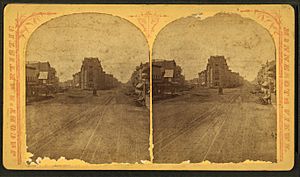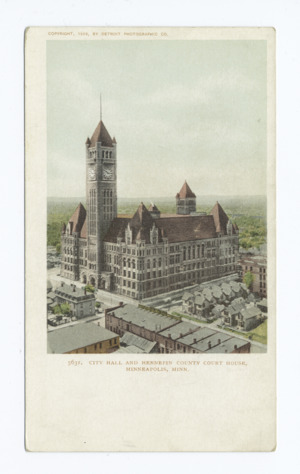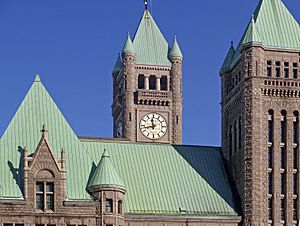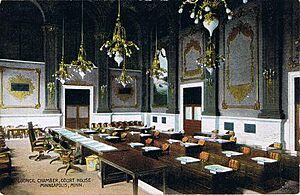Minneapolis City Hall facts for kids
Quick facts for kids |
|
|
Minneapolis City Hall-Hennepin County Courthouse
|
|
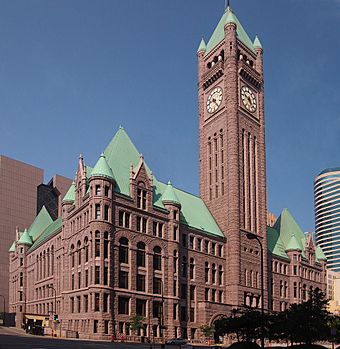 |
|
| Location | Minneapolis, Minnesota |
|---|---|
| Built | 1888–1909 |
| Built by | Charles F. Haglin and Charles Morse |
| Architect | Long and Kees |
| Architectural style | Richardsonian Romanesque |
| NRHP reference No. | 74001022 |
| Added to NRHP | December 4, 1974 |
The Minneapolis City Hall and Hennepin County Courthouse, also known as the Municipal Building, is a very important building in Minneapolis, Minnesota. It was designed by architects Long and Kees in 1888. This building is where the city government of Minneapolis and the government of Hennepin County, Minnesota do their work.
Since it was built, the building has mainly been used for local government offices. Today, about 60 percent of the building is used by the city, and 40 percent is used by the county. The city and county own the building together. A group called the Municipal Building Commission manages it. This group includes leaders from both the county and the city. The building looks a lot like city halls in Cincinnati and Toronto. In 1974, the City Hall and Courthouse was added to the National Register of Historic Places, which means it's a very important historical site.
Building Design and History
This grand building replaced an older City Hall that stood from 1873 until 1912. That first building was taken down to make space for Gateway Park, which is still there today. The new City Hall also replaced an earlier courthouse and the old Hennepin County Jail. The spot where the old jail was is now where U.S. Bank Stadium stands.
Before the first City Hall was built in 1873, city workers used to rent offices in the Pence Opera House building. That building was located at Hennepin Avenue and 2nd Street.
The City Hall and Courthouse is located at 350 South Fifth Street. It is a great example of Richardsonian Romanesque architecture. This style of building design was inspired by the Allegheny County Courthouse in Pittsburgh. Before this building could be constructed, Washington School, which was the first school west of the Mississippi River in Minneapolis, had to be taken down.
Work on the building started in 1889. The first stone, called the cornerstone, was placed in 1891. The building was officially finished in 1906, but most of the outside was done by 1895. The county government started moving into their part of the building in November 1895. The city government moved into their side in December 1902. The whole project cost about $3,554,000.
When it was built, the City Hall claimed to have the world's largest four-faced chiming clock. Each clock face is 24 feet, 6 inches wide. That's about 7.5 meters! This makes them 18 inches (45.7 cm) wider than the famous clock faces of the Great Clock in London. The tower that holds the clock is 345 feet (105 meters) tall. It was the tallest building in Minneapolis until the Foshay Tower was built in the 1920s.
The tower also has a set of 15 bells that play music. This chime is played regularly. You can even hear concerts at noon on holidays, Fridays, and some Sundays during warmer months. The chime originally had 10 bells and was first played on March 10, 1896.
The building is made from beautiful rose granite stone. This stone came from a quarry in Ortonville. Many of the stones weigh more than 20 tonnes! At first, the builders only planned to use granite for the bottom part of the building and brick for the top. But people loved how the granite foundation looked so much that they asked for the whole building to be made of it. This might be why the building cost more than expected. It was first thought to cost only $1.15 million.
Unlike many buildings in downtown Minneapolis, the City Hall doesn't have "skyways" connecting it to other buildings. Since buildings on the National Register of Historic Places cannot have their outside changed, tunnels were built instead. Public tunnels connect the building to the Hennepin County Government Center and to the U.S. Courthouse. There are also special tunnels for the sheriff to use, connecting to the Hennepin County Jail and the Government Center. The METRO Blue and Green light rail lines have a stop right outside the building, called the Government Plaza station.
Inside the Building
Inside the building, on the 4th Street side, there is a huge five-story rotunda. A rotunda is a large, round hall with a dome. In this rotunda, you'll find a big sculpture called "Father of Waters." This sculpture was created by an American artist named Larkin Goldsmith Mead. He was living in Florence, Italy at the time. People say that if you rub the sculpture's big toe, it will bring you good luck! It was placed inside the building in 1906.
The building originally had a red terracotta roof. But it started to leak, so a new copper roof was put on. This copper roof weighed 180,000 pounds (about 81.6 tonnes), and it was said to be the largest in the country at the time. Over the years, the copper has turned a greenish color. This color change is called a patina, and it happens naturally as copper ages.
Over time, some of the large open spaces inside the building were divided into smaller offices. In the 1940s and 1950s, the city added an extra floor, called a mezzanine, on its side of the third floor. The county also built an extra annex building in the courtyard. In 1981, a plan suggested changing some of these spaces back to their original design. It also suggested tearing down the annex building, putting a dome over the courtyard, and moving the "Father of Waters" sculpture there. Many parts of this plan were not carried out, but some of the historic areas have been restored to look like they did in the past.


